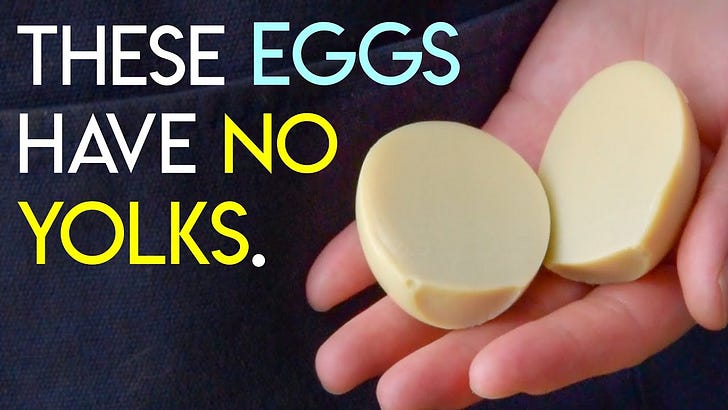Ok, so here's an egg. Looks like a normal hard boiled egg, right?
Now… peel it, cut it in half, and… there is no yolk.
Now maybe you immediately know what's going on here, but for me the first time I saw these they really kinda messed with my head.
So - give it a guess. How do you think this's done?
Is it something happening before the kitchen? Is the chicken farmer just messing around with the fertilization process? Is Mr. rooster firing blanks or…
Is this something happening in the kitchen? I mean, this is same cuisine that's given us fish that looks like congee, tofu that looks like goose skin, and chicken that looks like tofu… so just separating out a yolk wouldn't exactly be a stretch, but like… how would the egg be staying the same volume?
The answer?
Yes.
Balut/penoy culture in China
See, you might be familiar with the tradition of Balut in southeast Asia – that is, the snack of semi-developed duck eggs that sorta taste halfway between a boiled egg and a hunk of chicken. Less well known is that China also has a Balut culture - in pockets, the Northeast of the country being one. Now if you're making Balut, as a sort of side product you also end up getting some of what's referred to in the Philippines as Penoy – that is, infertile incubated eggs.
So over time, in China's Northeast those yolk-less, or I guess equally white-less, Penoy-style eggs ended up getting really popular at Chinese barbecue joints – they're practically made to skewer and grill. They ended up getting so popular that demand outstripped supply, and vendors innovated.
Solid Eggs: Making 'Penoy' eggs with a normal egg
Here’s how they're generally made nowadays:
Eggs, 5.
Water, ½ tbsp.
Kansui a.k.a. lye water (枧水), ½ tsp.
Salt, ½ tsp.
Using the large end of a chopstick, crack the narrow side of 5 eggs. Make a hole with the narrow side of the chopstick, clean up the hole with a pair of tweezers. Remove the egg.
Rinse the egg shells.
Add 1/2 tbsp water, 1/2 tsp kansui (lye water), and 1/2 tsp salt to the eggs. Beat in a zigzag motion so as not to incorporate too much air. Once no stray strands of egg white remain, strain. Knock the bowl a couple times against the table ala a cake batter to let some air bubbles float to the top. Skim off the bubbles.
Add the egg back into the shells. Put the eggs in little bowls or ramekins to stand up nicely. Steam over a low flame for 20 minutes.
Transfer the eggs to cool water, peel.
Solid Egg Stir Fry
Solid eggs, 5.
Aromatics:
Onion, ¼. Sliced.
Garlic, 2 cloves. Minced.
Spices:
Chili powder (辣椒面), ½ tbsp.
Cumin powder (孜然面), ½ tbsp.
Soy sauce (生抽), 1 tsp.
Seasoning:
Sugar, ¼ tsp.
MSG (味精), ~1/16 tsp.
Herbs:
Scallion, 15g. Chopped.
Cilantro, 15g. Chopped.
Toasted sesame seeds, ~1 tsp.
Slice 5 solid eggs into ~4 slices, then cut each slice in half.
Slice a quarter of an onion. Mince two cloves of garlic. Chop 15g each scallion and cilantro.
To stir-fry, first longyau: piping hot wok, add ~1 tbsp oil, shut off the heat, give it a swirl to get a nice nonstick surface. Flame on high, add in the eggs and the aromatics. Stir fry until the eggs begin to blister, 1-2 minutes, then add in the spices - 1/2 tbsp chili powder, 1/2 tbsp cumin powder - and fry til fragrant, ~1 minute. Swirl in 1 tsp soy sauce and add in the seasoning (1/4 tsp sugar, ~1/16 tsp MSG). Quick mix, add in the herbs another quick mix, heat off, add ~1 tsp toasted sesame seeds.





